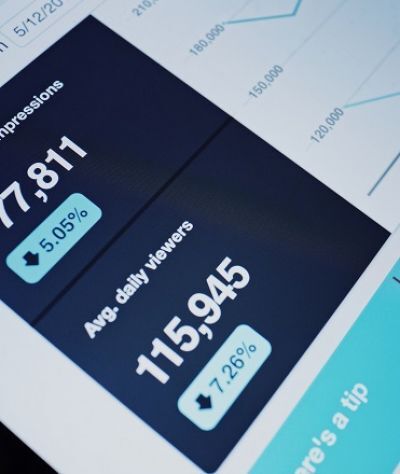What Is Digital Marketing Strategy? (And How To Create One)

- Summary
- Content Presentation, Generation, and Optimization (Web Design, Copywriting, SEO)
- Conversion Rate Optimization (CRO): Ensuring Each Page Becomes Its Best Possible Version
- Customer Relationship Management (CRM): Keeping Prospects Happy, and Clients Happier
- How Much Does It Cost to Attract a Client and How Long Do They Remain as Customers? (CLV)
- Paid Search and Paid Social Media: Getting That Extra Bang for Your Buck
- Analytics and Metrics: Making Choices Based on Hard Data
- Marketing Services and Support (Digital Agencies): Getting Your Marketing Team the Help They Need
Get Optimal ROI from Your Inbound Digital Marketing
There was a time – not too long ago – when marketing in the digital arena was as basic as buying space for ads on websites or posting promotional material on social media. Learning how to create a digital marketing strategy was easier because the internet was simpler. A company could execute a series of thinly aligned tactics without the need to create an overall strategy.
That’s no longer the case.
With the increased creation and popularity of social media platforms, the over-saturation of content across the web, and the large number of businesses competing for traffic, your company needs to think in strategic terms in order to ensure your digital presence becomes effective at acquiring quality traffic. Otherwise, you’ll just be a tiny speck floating aimlessly in an ocean of indistinguishable particles.
Regardless of the type of marketing channel you are looking into – whether e-mail, social media, affiliate, content, paid, or even multilingual – you need a strategy in place to get the best results.
Why Invest Time and Resources into Creating a Digital Marketing Strategy?
- It helps you align and focus all your efforts in specific directions, to accomplish explicit objectives.
- It helps differentiate your brand from the rest by creating a unique voice.
- By perfecting the way you engage with your prospects and customers, you’ll gain new insights into their behaviors, allowing you to tailor all your tactics to their specific needs, which in turn will increase the effectiveness and reach of your strategy.
- It provides a roadmap to help streamline efforts, optimize results, and even reduce costs by choosing how to execute at a tactical level, whether in-house or by outsourcing tasks.
Prior to the creation of any plan, you need to have some idea of the resources that are available to you. The very task of developing the strategy will be tedious and inefficient if you don’t have an estimated budget assigned to this particular area of work, as well as an idea of the team members who will actively engage in following it through.
To develop a digital marketing strategy, you also need to be acquainted with the more important elements surrounding inbound digital marketing and engagement, including but not limited to the following.
Prior to the creation of any plan, you need to have some idea of the resources that are available to you. The very task of developing the strategy will be tedious and inefficient if you don’t have an estimated budget assigned to this particular area of work, as well as an idea of the team members who will actively engage in following it through.
To develop a digital marketing strategy, you also need to be acquainted with the more important elements surrounding inbound digital marketing and engagement, including but not limited to the following.

Your company website is the main gateway through which most (if not all) of your prospects will pass before becoming actual customers. That means it needs to be designed for efficiency, appeal, and smoothness of user experience. Without properly developing these components, inbound traffic will fail to convert or, even worse, leave without any significant engagement.
Basic web design concepts should be employed in the creation of your website to ensure optimal results.
[Check out our Basics of Web Design and Understanding Web Development guides for more information on these subjects.]
How the pages are set up and laid out isn’t enough. The content itself must be relevant and interesting. Careful attention should be placed on creating engaging material for visitors to connect with.
Here are some best practices in terms of writing content for the web:
- Make sure the introduction can hook people. The content should begin with ideas or questions or statements that shock, entertain, awe, interest, or inspire. If the reader is not hooked within those first few lines, chances are he or she will leave the page. Speaking of which…
- Keep the main idea above the fold. The fold is that bottom line where most screens cut off the initial display. Make sure your first (or at least the second) paragraph succinctly explains what the content is about. Readers want to be sure what they’re getting into before going forward.
- Use multimedia. Images, videos, and infographics are all valid tools to keep your content dynamic. Too much text on a screen can feel burdensome for some readers, and the idea is to keep them engaged.
- Use your own voice. Every company and every brand has a unique voice. You want people who visit your company website to know what yours is. Be sure that all your content matches it. If visitors feel the tone is insincere or that something is off, even if it’s at some unconscious level, they are more likely to leave or react negatively.
Writing is by no means an exact science, but there is some common ground that most people can agree on. As a good point of reference, the University of Maryland in Baltimore put together a nice list of best practices to keep in mind when creating web content.
Once you’ve got the website and content ready, it’s time to start thinking in terms of ways to ensure the material is found. The best (and cheapest) way to accomplish this is by optimizing content so it can be found organically through search engines, which is achieved through search engine optimization (SEO).
Search engines power the internet. It’s estimated that Google alone processes over 3.5 billion queries every single day. With staggering numbers like those, companies have to work hard to get content ranked in those highly coveted first results pages. It’s imperative to apply proper SEO as part of your digital marketing strategy.
How Do You Optimize for Search Engine Results (SEO)?
Search engines operate by quickly crawling through every single indexed website when a query is performed and then processing the information with an algorithm that assigns a rank to each page based on a very specific set of criteria.
While the details surrounding that process are kept under wraps, some parameters have been proven to influence rank. Examples include:
- Use of keywords that clearly define the topic being addressed by the content
- The number of links, both internal and external, that connect to and from each page
- The number of quality visits and level of engagement each page gets
- Valuable, unique (not copied or reworked) content
What this means for your content is that you need to ensure that it addresses each of these points so the page can obtain a higher rank and increase your chances of showing up on that coveted first page. Setting the content apart from all the other material of the same subject saturating the searchable landscape is key.

By showing up on that first page, your company is boosting the probability of getting new traffic, which itself is an important metric for engines such as Google when assigning rank. This is called the Click-Through Rate (CTR), which much like the name describes, is the rate at which users who perform a query (i.e. search) click to access your content. This metric helps establish credibility for the content and authority for your website as a whole.
A great reference to get these basics down – and a very wise instructional choice if you’re learning the ropes – is Moz’ renowned guide for SEO beginners.
Making these considerations a part of your marketing strategy will ensure optimal results in luring organic traffic to your website, which is where the journey begins for visitors, who will then decide just how much they engage with what they find.
Traffic is not enough. You need to optimize your website for conversion so those visitors become quality leads, which means they engage with what they find and become potential customers or clients.
CRO is a very systematic solution that consists of – step by step – improving each page on your website so it becomes its own best possible version. This is not improvisation or guesswork based on what you think will fix issues or boost engagement. It’s proven tools and methods that render insights from data to give you direction.
What Are the Steps to Optimize a Page for Conversions?
First, you need to audit your website. With the help of tools such as Hotjar, you can assess page performance through heat maps that reveal click and scrolling engagement. This powerful service also provides anonymous recordings of page visits, showing exactly what each visiting user did, what he or she stopped to read, where his or her cursor moved, and what they chose to click.

This cornucopia of information can be used to determine what areas of the pages aren’t getting attention or engagement. That’s the kind of data that experienced minds can use to define concrete and effective changes that will radically improve performance.
This is an intricate process. Your team should be knowledgeable if you expect to keep testing trial and error to a minimum. If you plan to employ digital marketing services from a third party, it’s a good idea to make sure they have the tools and know-how they need to boost your conversion rate.
The O8 marketing team is full of experienced conversion rate optimizers. Learn more here.
Once visitors are attracted to a page and significantly engage with the content, they become leads. Leads are like small seeds that need to be nurtured and cared for so they’ll blossom into customers. The best way to accomplish this – and, of course, a key component of any digital marketing plan – is to have efficient Customer Relationship Management (CRM) tools in place.
What a CRM service or software does is provide a series of tools to obtain contact information from those who engage with the content, and sort it out efficiently so your sales, client relations, or any client-facing department can quickly access it if necessary.
How that information is obtained is entirely up to you, as it requires implementing changes on your website so visitors willingly hand it over. This is another point where conversion optimization comes into play, as it’ll help you define which solution is the best for this particular objective.
Some common tactics:
- A simple form for subscribing to a weekly newsletter
- A call-to-action button to download a free guide in exchange for submitting contact information
- A contest or sweepstakes that requires creating an account on your website
Using data to determine which alternative works will be crucial in increasing your database of prospects.
A CRM also keeps existing customers engaged. By keeping tabs on those who’ve already become clients and applying some clever marketing tactics to keep that interest going, companies can cross-sell, upsell, and resell.
Customer Lifetime Value (CLV) is a metric that determines how valuable each client is to your company in the long run. The reason this particular piece of information is useful is that it can be compared to the cost of acquisition in order to learn if the current business model and practices will be profitable or not.
As part of your digital marketing strategy, this metric serves as the foundation from which customer acquisition and retention tactics will grow. If your CLV for each client is lower than what it cost your company to bring them in, then your strategy needs to be restructured in order to reduce costs.
Calculating CLV should not be a daunting process as long as you understand the math and science behind it.
Paid search and social advertisements are a quick and usually very effective way of driving revenue. That’s why it usually makes sense to set aside some budget for them. They’re also easy to manage for experienced advertisers.
First and foremost, search ads (SEM ads) and most social media ads offer immediate data that can be used to optimize to an extreme level. While that doesn’t always translate to satisfactory results, it means your company can adjust targeting and retargeting almost to the point where nobody outside of the target demographic sees an ad. And the ads can be A/B tested over and over for great results. In non-technical terms, this means the right people see the right content at the right time, which motivates them to buy.
While ads are usually affordable and can be easier to manage, any paid ad strategist will tell you that there is a science to it all. Learning the basics of paid search is extremely important if your company wishes to find success.

For paid social media, your company needs to be very careful and astute when making choices. It’s very important to understand who your prospects (or target personas) are. This will help you narrow down the list of platforms in consideration. Each social media platform tends to have its own set of demographics, so knowing what your prospects are more likely to use will increase your success rate.
As a reference, the people at Hootsuite compiled a list that offers a rather nice overview of demographics per platform. Be sure to plan your creative (text and images) with a clear understanding of what your target audience is most likely to connect with.
A good digital marketing strategy avoids speculation and bases decisions on accurate information. As your marketing work progresses, your company will start gaining hard data, which you’ll need to use to reshape, refocus and retarget all efforts in order to optimize and maximize results.
Data can come from all types of sources. Social media platforms, for example, use their own set of metrics based on performance, which is certainly very useful. But there is one tool that is remarkable in terms of understanding the traffic that reaches your website.
Enter Google Analytics.
Google Analytics’ tracking code acquires information such as which pages visitors reach, where they’re coming from – both source and medium – how long they stay, how often they engage with other pages, and several other metrics. Analytics also logs demographic info such as visitor location and age.

This data is valuable during the campaign optimization process because it shows you just how successful the marketing tactics are and how they can be better. While revenue and ROI are the ultimate measures of success, data from Analytics can help you understand how to cut marketing costs and even how to maximize close rates by targeting the right audience. In other words, Analytics helps you know what works and what doesn’t.
Analytics can be confusing for the inexperienced, but Google offers courses that are really helpful.
Inbound digital marketing work requires a broad range of tools and competencies. Poor results are common, unfortunately. It’s also quite common to notice burnout among team members and, as a result, high turnover rates. These effects are generally caused by a lack of experience or preparedness. Don’t underestimate the tasks at hand.
Digital agencies provide an array of services that help to relieve overburdened marketing departments, especially in medium to large companies where the flow of tasks is continuous. They also make it easier to find out how to create a digital marketing strategy that fits your specific needs.
The products offered by an auxiliary marketing team can range from web development and design to all the different aspects of digital marketing, which is why it is imperative to sit down and examine which areas the company needs assistance with.
Choosing the right marketing or web design agency is a delicate process, one which should not be taken lightly because of impact it’ll have on your company’s overall digital performance.
Original Article Written by Joe Yaker

